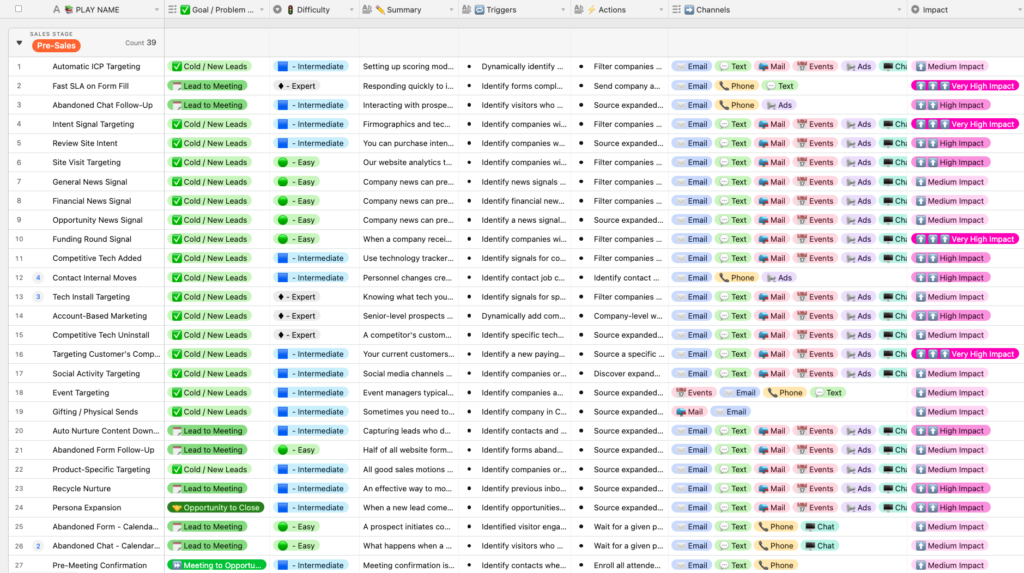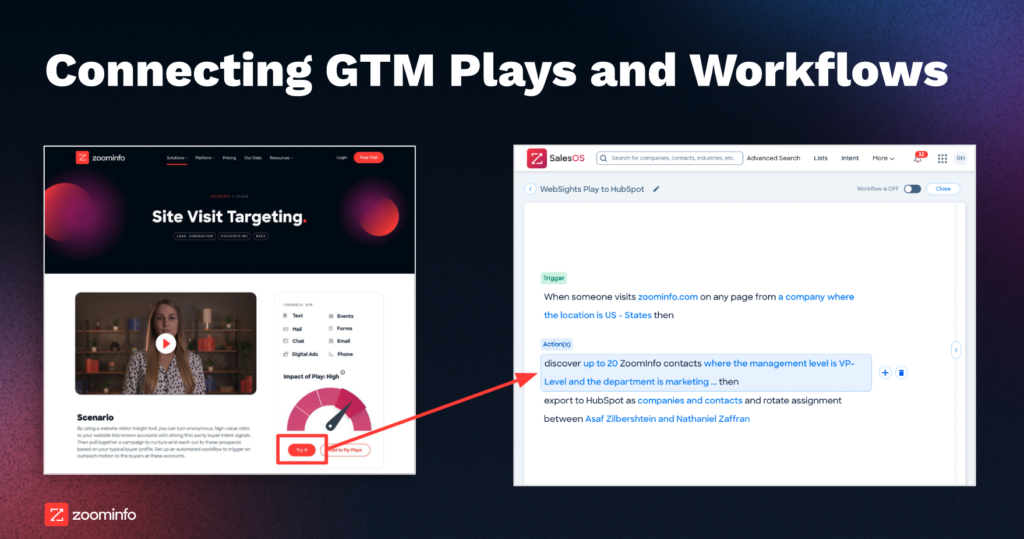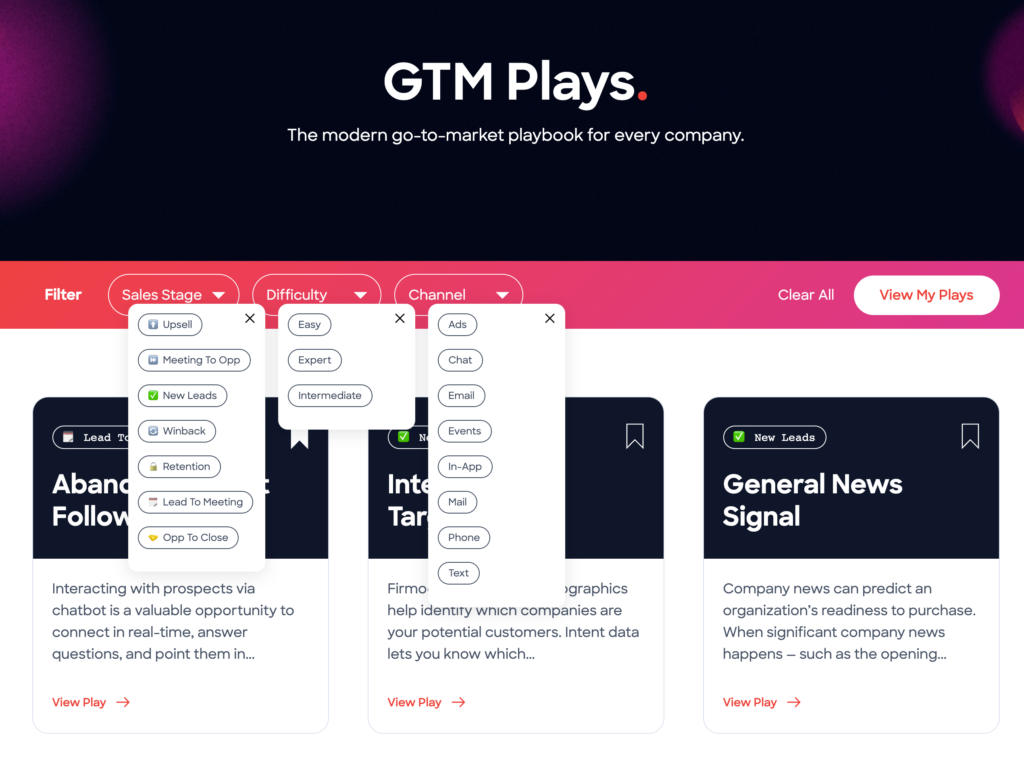Just as sports teams use playbooks to map out potential in-game scenarios, the best go-to-market (GTM) teams rely on playbooks to map out their revenue-generating strategy across sales and marketing. They’re essential for preparing your team for every situation that may arise during a demo, sales call, or in-person event.
Playbooks can also improve prospecting and customer upsells, identify untapped opportunities, and make each salesperson and marketer more effective. To do that, a playbook has to operate more as what Harvard Business Review refers to as “Moneyball for Sales” — an ecosystem of workable plays that rely on large-scale data sourcing and analytics to drive real success.
What is a Play?
Plenty of companies have sales and marketing plays, but not all plays are created equal. At ZoomInfo, we’ve spent a lot of time thinking about and optimizing the way plays work and what makes them successful. Here’s our definition:
A play is a coordinated, repeatable process that drives a sales, marketing, revenue operations or recruiting outcome that can be run across companies. Each play includes:
Specific inputs which inform targeting/audience building
Triggers that kick off the play
A unique set of steps that create a recipe for the play
An engagement output with prospects via one or more channels, including: ads, email, chat, phone, text or mail
The Sales Playbook: A Look Back
Historically, teams relied on a sales playbook bound in a binder that individuals could reference before going out on sales calls. Plays typically included several options for how conversations could go, a few objection-handling scenarios, and a lot of product details.
Cutco has a great example of a traditional sales playbook that probably worked really well. The knife manufacturer’s playbook included a list of compliments to pay prospects, encouraged reps to use leather, penny and rope to demonstrate the effectiveness of their products, and gave tips for sales people that have stumbled upon a house that already has Cutco knives (demo anyway!).
Four things that immediately stand out about this traditional playbook:
Salespeople relied on proximity
Relationships were the driving force behind making a sale
Availability of prospects was essential
Iteration wasn’t possible
While this playbook proved successful for Cutco — I remember my family buying a set of Cutco knives — it’s become outdated and definitely won’t work for companies trying to target consumers in the digital world we now live in.
The Problems with Sales Playbooks
There are plenty of pitfalls when it comes to today’s playbooks, mostly stemming from an explosion of raw data without altered processes. Here are a few examples:
Trouble connecting with customers
For this reason, GTM teams must rely on data more than ever before to reach their target audience. Salespeople can’t simply depend on the familiar tactics of going door-to-door, or connecting on a call, or complimenting someone’s curtains. They need data-driven insights that identify the potential needs of their prospects to create effective, targeted customer outreach.
A lack of data-driven, iterative plays
Even the best plays get stale, so it’s important to make them as dynamic and customizable as possible. This can be done with high-quality data and automation built into your plays. However, research by IDC found that nearly 70% of enterprise data goes unused.
Without the ability to harness data and effectively turn it into prospecting, playbooks don’t work as well as they should. Additionally, companies typically create messages that match the lowest common denominator of their prospect list, as opposed to finding specific reasons someone would find their product useful. This shortfall often comes back to a lack of usable data.

Absence of scalability
In our digital-first world, plays need to be original while still feeling relevant to grab the attention of prospects. And playbooks need to be scalable, with the ability to instantly customize and leverage data for targeting, segmentation, and content pivots.
No GTM alignment
Lastly, playbooks often fail to address sales and marketing alignment — a key component of successful GTM teams. If your marketing efforts don’t lend to sales success, they’re useless, and vice versa. Messaging, goals, metrics, and general operational integration should be the same across teams to ensure that your sales plays drive sales, marketing, and revenue ops success.

The Modern Sales Playbook
At ZoomInfo, we want scalable plays to be accessible and actionable, because that’s the future of GTM. Unfortunately, there’s a huge gap between today’s sales playbook and what modern GTM teams need. That’s why we’re taking the tried and tested plays that the GTM team at ZoomInfo uses and making them available to everyone.
With ZI Labs, we’re helping companies implement scalable plays that make every motion more effective. These plays build alignment across sales, marketing, and revenue operations teams to ensure your GTM strategy is successful across your entire business.
We’ve tested hundreds of plays using a collection of data points from our best customers to make every touchpoint more impactful and show prospects that you deeply understand their challenges. These plays also include triggers that can help you capture prospects when they’re most likely to buy.
With our modern sales playbook, you can harness the data at your fingertips, create targeted and relevant messaging, and develop meaningful relationships with your best-fit prospects — all through an automated, seamless experience.
See our plays here, and make them your own.



